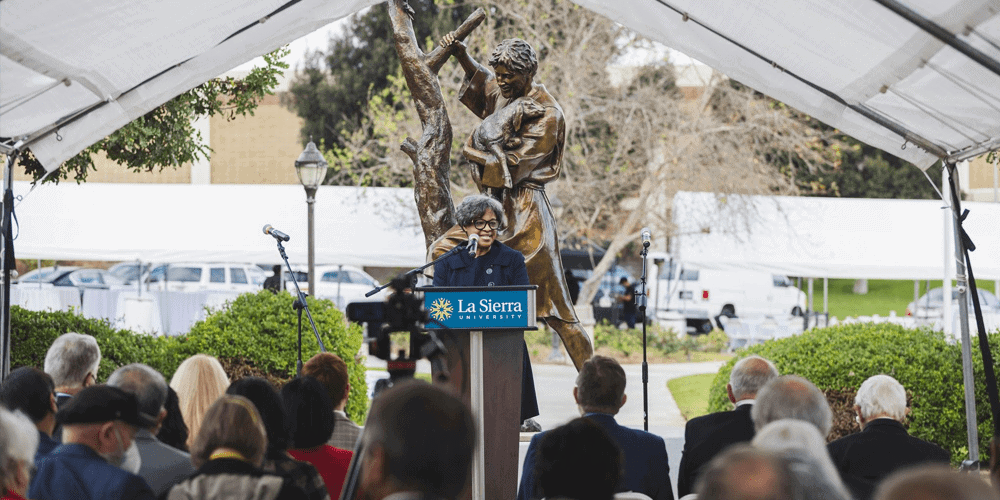
Under cool, cloudy skies that eventually gave way to the sun, roughly 250 La Sierra University alumni, current and former leaders, campus, and community members gathered February 15, 2022, to begin the commemoration of a significant milestone — the school’s 100th anniversary.
Serving as the first of three main celebrations planned this year, the inaugural event centered on the dedication of “The Lost Sheep,” a new campus sculpture situated within a grove of carob trees — a nearly 10-foot (3-meter) tall bronze illustration of the biblical parable of the lost sheep. The sculpture is the third and final piece in a series titled the “Glory of God’s Grace” that is based on three parables in Luke 15 — the prodigal or lost son, the lost coin, and the lost sheep. A sculpture depicting the lost coin was unveiled on La Sierra’s campus in April 2017 while the anchoring work, an iconic sculptured tableau, was installed in 2002, surrounded by a reflecting pool and centering the university’s main plaza.
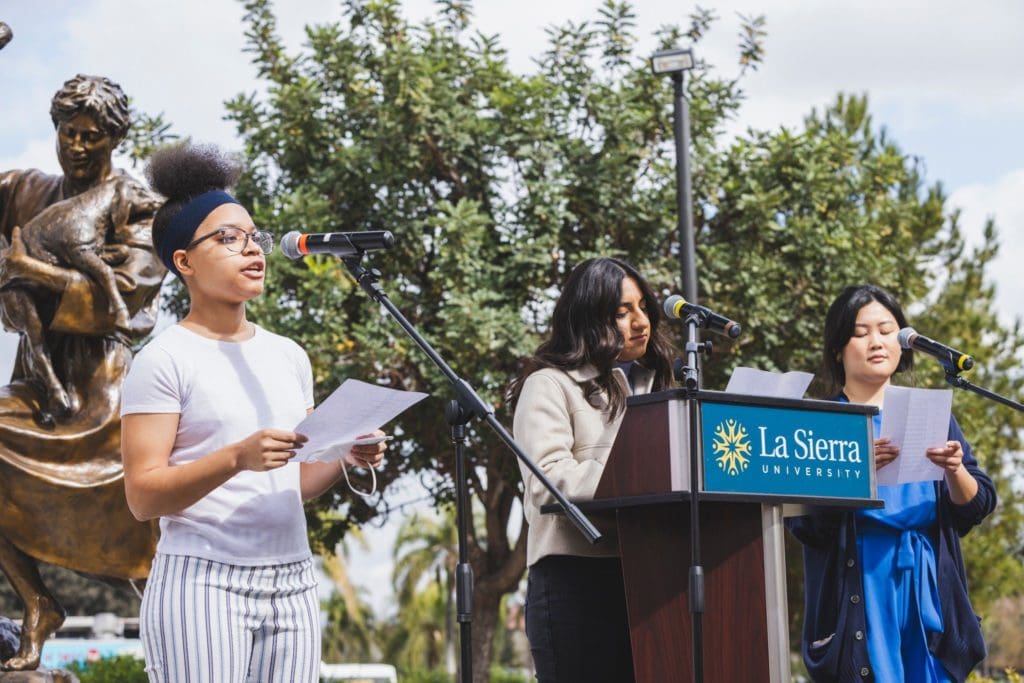
“It’s fitting that we gather here among the carob trees on this occasion. These trees, the pods of which are claimed by some biblical historians to have formed the diet of John the Baptist, the herald of grace to come, Jesus Christ, who then gave us the three stories in Luke Chapter 15 that reveal the glory of God’s undeserved favor and love,” La Sierra University president Joy Fehr said in her address for the dedication event. Fehr took up the presidency in 2019 as the first female president in the university’s history and has led the institution during the COVID-19 pandemic that swept through the nation and region just a few months after she took office, requiring its immediate shift to months of online learning.
In her address, Fehr detailed moments of grace and blessing the university and its members have experienced throughout its history, which laid the foundations of its identity, beginning with the backstory of its land. The property on which the campus sits was once part of a Mexican land grant awarded in 1846 to María Sepúlveda, a widow with small children who had appealed to the region’s last Mexican governor for a share of her deceased husband’s property. She was awarded 17,774 acres (around 7,200 hectares), and was the first woman to receive such a grant. Seventy-six years later, a portion of that property was purchased for the location of La Sierra Academy, the forerunner to La Sierra University.
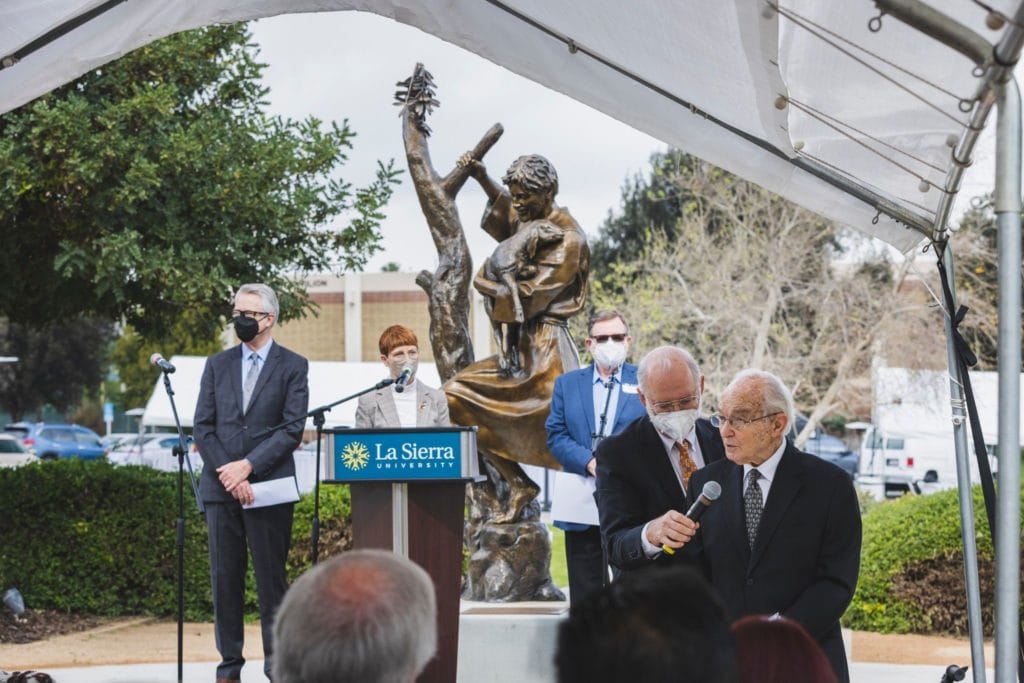
During opening remarks, Fehr noted the deep conviction, faith, and determination of La Sierra’s founders from the Seventh-day Adventist Southern and Southeastern California conferences who laid the groundwork for an institution of higher learning, the first in Riverside County, aided by numerous volunteers, donors, and the Riverside civic community that ponied up US$15,000 to help secure its location.
It first took shape as two buildings that formed La Sierra Academy, with classes beginning on October 3, 1922, during a particularly hot autumn. Some of the school’s 84 students had to climb ladders to reach dorm rooms. They shoveled out sand that blew in through partially finished construction that also lacked electrical wiring. The buildings were completed, more were constructed, and students continued to arrive. In 1927 the school became Southern California Junior College; in 1946 it was accredited as a four-year liberal arts college. In 1990 the institution was reorganized as a university following a separation from Loma Linda University under which it had operated as its College of Arts and Science since 1967.
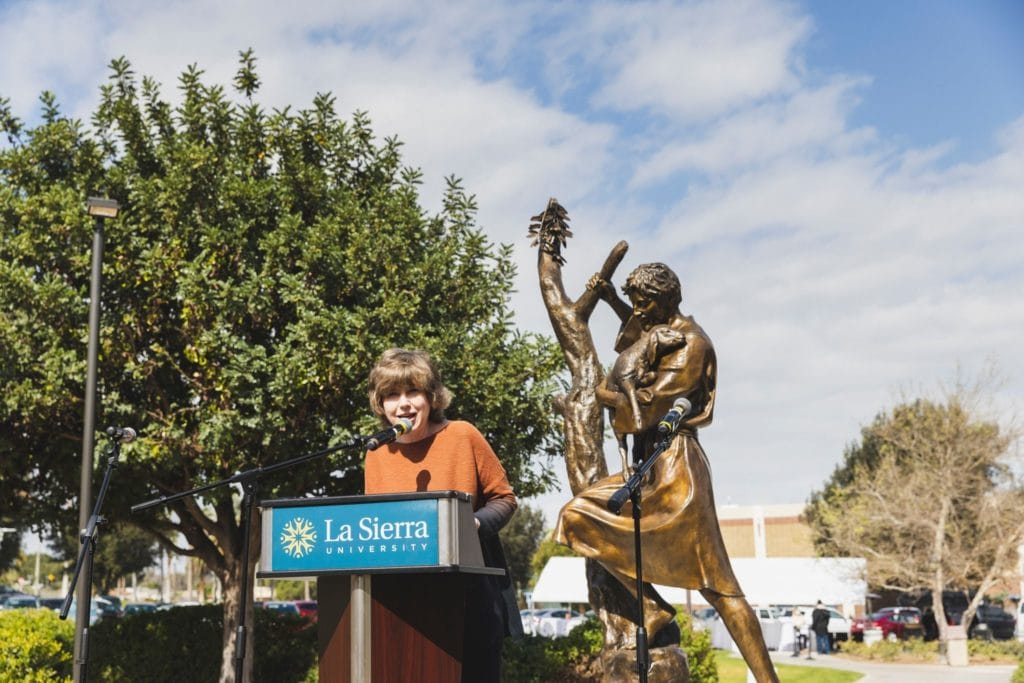
Now nationally-acclaimed for the diversity of its campus and for its service to others, La Sierra University’s faculty, the majority of whom hold doctoral degrees, teach roughly 2,000 students from around the United States and more than 50 countries. Located in the middle of campus, the watermelon patch that was part of the university’s agricultural past eventually became the current park-like expanse known as Founders’ Green, which is lined by the university’s early buildings and shaded by towering fan palms and sprawling Chinese elms.
Of Parables and Progress
“One of my concerns from the very beginning was that we be a real university, a place where knowledge is expanded, where new ideas, new understandings are developed. And thus, human existence, human experience is enriched,” Fritz Guy, La Sierra’s president from 1990-93, said, during remarks offered by the four presidents who led the institution since 1990. Guy is also an alumnus who first arrived to study at La Sierra College in 1948 at the age of 18 and witnessed its metamorphosis. Years later he led the charge in establishing a Seventh-day Adventist university community dedicated to Adventist theology and furthering its progress. “As we celebrate La Sierra’s first 100 years, I look forward to the university’s continuing contributions to Seventh-day Adventist thinking and living and serving,” he said.
Educator and archaeologist Lawrence Geraty served as La Sierra’s president from 1993-2007. Following his retirement, he was recognized with the title of president emeritus. His tenure oversaw considerable growth in the fledgling university’s enrollment, the formation of a university foundation board of community leaders, the addition of new campus facilities, and extensive renovations to the campus entrance as part of an overall redevelopment of university property along Riverwalk Parkway that resulted in a US$100 million endowment for the school.
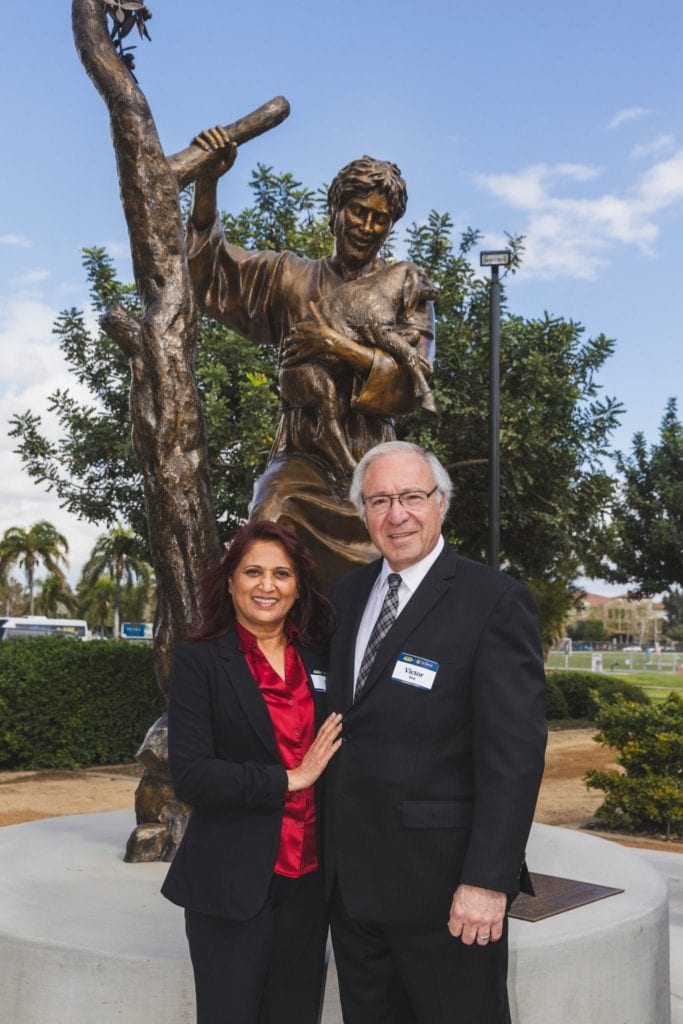
The university’s identity as a home for many was also carefully considered. Out of that work arose the concept for the centrally located prodigal son sculpture titled the “Glory of God’s Grace” created by the late Alan Collins and contributed by donor and alumnus Thaine B. Price who chose its name. Price also later contributed the university’s Price Science Complex. “I began thinking of how we could complete a trilogy of campus sculptures based on Jesus’ Luke 15 parables,” Geraty said during his remarks. The idea began to take shape with funding for “The Lost Coin” sculpture concept contributed by alumnus Calvin Hanson and the Versacare Foundation.
“Today I’m thrilled that the dream is completed with ‘The Lost Sheep’ sculpture celebrating 100 years of God’s grace to La Sierra University,” Geraty said. “With the encouragement of what is signified by this concept, it is our hope that all will feel welcomed home on this campus. Home is most meaningful when we find grace there.”

Randal Wisbey, La Sierra’s third president, served in the office for 12 years before retiring in 2019. During this time the university continued its upward trajectory to reach its highest enrollments, welcomed a new school of business facility named for donors Tom and Vi Zapara, and witnessed the installation of the second sculpture in the series depicting the lost coin parable.
Wisbey, whose son and daughter-in-law graduated from La Sierra, noted the personal impact the institution has made. “La Sierra changed my life, and my family’s lives — professionally, academically, and personally — and I am honored to participate in its centennial celebrations,” Wisbey said. “As we dedicate this final sculpture, I remain grateful that the ‘Glory of God’s Grace’ will be a living and profound testament to the truth that all who step onto this campus are welcomed with open arms, and that there is rejoicing when something that has been lost is found.”

“As doctors Guy, Wisbey, and Geraty have already expressed, there is much meaning behind the three sculptures that now stand on our campus,” Fehr said in concluding the presidential remarks. “They embody our university’s identity as a place where grace is paramount, where we have seen God’s blessing and compassion repeatedly during these 100 years.”
Professor of New Testament Studies Kendra Haloviak Valentine noted in a homily for the sculpture dedication that the lost sheep parable is the first of three Jesus told, as described in Luke 15, and he told it “in the context of people grumbling, that Jesus was hanging out with sinners, even eating with them. And as Jesus hears their grumbling, He starts telling stories of a lost sheep and a lost coin and lost sons. I don't know if you’ve read Luke’s account of this parable in a while but it’s fun to see that there’s far more about the rejoicing after finding the lost sheep than there is about the lostness of the sheep,” Valentine said.
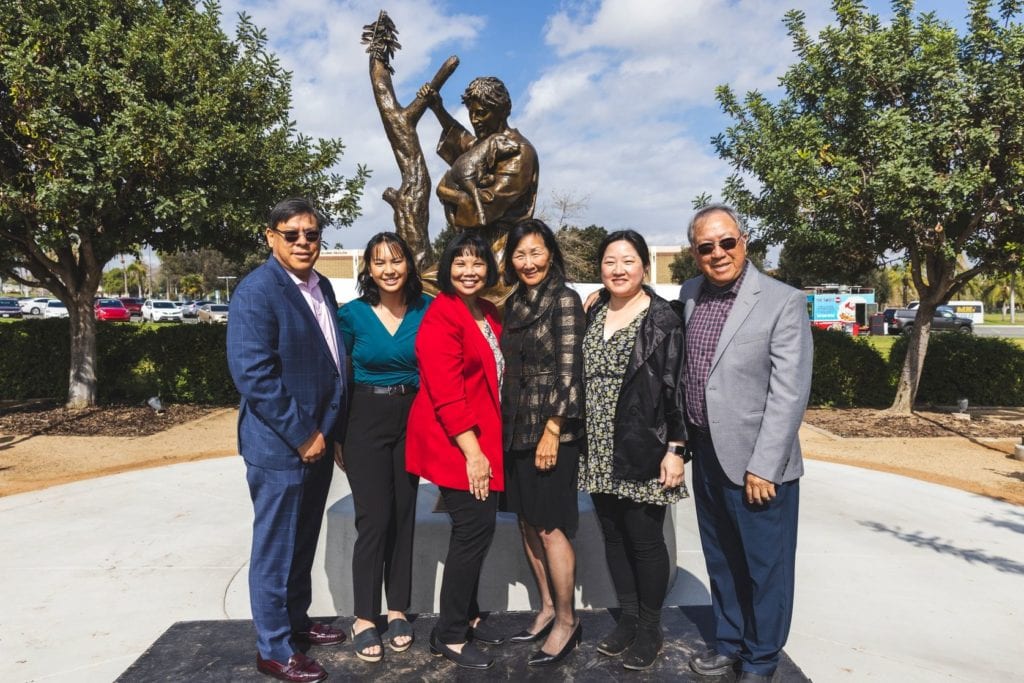
“We as a community acknowledge Scripture’s stories of faith and hope, and we acknowledge the role of art in communicating our faith. … The trilogy of parables portrayed on our campus call us in 2022 to consider the losses experienced by so many — the loss of creatures in a warming globe, the loss of resources in broken economies, the loss of family members in a pandemic, where, once again, the most vulnerable are the ones now missing among us. But these parables proclaim that loss is not the end of the story. The lamb is found. The coin is found. The sons are found. There is restoration of creatures, resources, and loved ones. Our sculptures proclaim a faith of restoration,” Valentine said.
Moved by Grace
It was the grace-filled lives of their family members, the love and dedication shown to numerous others through careers of service and personal outreach, and a desire to further the gospel message through the Seventh-day Adventist faith that inspired the Hwang and Toh families to contribute “The Lost Sheep” sculpture to La Sierra’s campus. The sculpture provides an opportunity for young people on the campus in particular to “find comfort and inspiration” as they linger near it, said Jean Toh in comments for the dedication ceremony. She and her brother Ernie Hwang are La Sierra alums, with Ernie serving as a member of the Board of Trustees. The sculpture is dedicated to the memory and lives of their parents, Thelma and Paul Hwang, and to Brandon Toh, son of Jean and her husband, John Toh.
“Our family is grateful for the opportunity to honor their lives where they valued, supported, and gave hope to those who felt lost,” Jean said. Paul, a physician, and his wife Thelma Hwang served the Seventh-day Adventist church in their native China before immigrating to the United States after World War II. While in China, the Hwangs befriended Geraty’s family whose parents were serving as missionaries there at the time. In the U.S., the Hwangs founded the Mojave and Los Angeles Seventh-day Adventist churches. “They befriended and helped many people from all backgrounds and opened their home to students who had come alone to the United States. They supported and helped them find their way in a new country,” Jean noted.

Brandon, diagnosed as an adult with bipolar disorder, used his knowledge toward erasing the stigma of mental illness and served more than 10 years as a suicide counselor at Didi Hirsch Mental Health Services, Jean continued. “He knew the challenges many young people faced of feeling alone and isolated, and in his interventions bridged the gap by listening and giving voice to those who felt hopeless or had no one to turn to.”
For sculptor Victor Issa, who also created the sculpture depicting the lost coin parable, meeting those whose contributions support the artworks is a poignant moment.
“Having the opportunity to meet the donor families is always an honor and a joy. They do take a risk and I take the commission very seriously, and I do my best to meet and exceed their expectations,” he said. “May the sculpture touch many lives as the viewers contemplate the knowledge that the Good Shepherd will seek every lost sheep.”
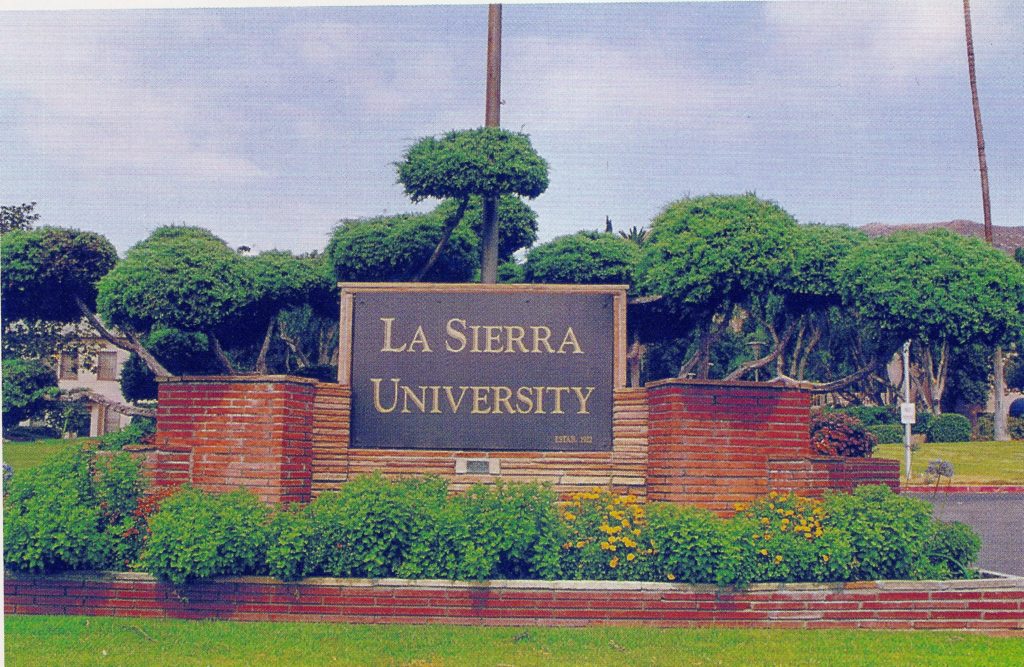
The sculpture was created at 133% of life-size, Issa said. The bronze monument was developed during a complex process that took more than two years and began with a detailed maquette or small concept version for the client. The following steps involved a live model for the clay work, a rubber and plaster negative copy and a technical foundry process. Issa’s model for the sculpture was a young man “whose facial features perfectly reflected what I was hoping to portray — compassion, kindness, assurance, and deep love,” he said.
Changes for the Better
The February 15 audience included alumni and community members who attended to view the new sculpture and celebrate the university’s commencement of its centennial events.
Eddie and Rosebud Ngo arrived from Redlands where Eddie is a certified financial planner. The couple met in 1961 while Eddie was a business major before transferring to Pepperdine University. Rosebud studied as a pre-health major in health information systems before transferring to Loma Linda University in 1962 and beginning a medical records career.
The couple recalled their days at La Sierra, when Eddie worked sweeping the walkways outside of Hole Memorial Auditorium and Rosebud lived in Angwin Hall. “I’m a business major so I would like to see [the business school] push to continue on and hopefully rank in the top 10 business schools in the United States,” Eddie said when asked about his hopes for his alma mater’s future.
They both enjoyed the sculpture dedication. “It was very, very nice,” Eddie said, adding that the campus is much changed from when they were students there. “It’s much better,” Rosebud noted.
“It was a lovely event with excellent speakers and really makes you see how the president has done a terrific job of presenting the whole picture to everyone,” Marcia Gilman, wife of university foundation board member and Riverside attorney Dan Hantman, said. The couple were drawn to the university and involvement in its board through their friendship and support of Geraty during his presidency.
“I had occasion to be out in this area before it is what it is now,” Gilman noted. “It’s amazing. You look at the Riverwalk and how that’s changed. This area used to be farmland. It’s just amazing ... how much influence this university has had.”
The original version of this story was posted by La Sierra University.